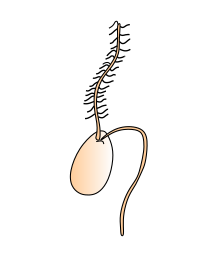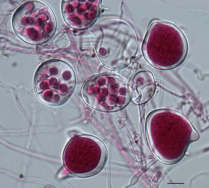218:
286:
31:
151:
536:
99:
Zoospores are composed of a microtubular cytoskeleton base which extends from the base of the flagellum. The complexity and structure of this cytoskeleton is variable and is largely dependent on volume and size. One common feature of zoospores is their asymmetrical shape; a result of the ventral
246:, induces the sporangial cytoplasm to split and release the various zoospores. Release of the spores can occur either inside of the zoosporangium (intrasporangial zoosporogenesis) or exteriorly (extrasporangial zoosporogenesis). Spores absorb water and travel through the
100:
grove housing the flagella base. Certain zoospores progress through different phases, the first phase commonly referred to as 'the initial'. Others form cysts that vary tremendously in volume (14-4905 cubic micrometers) and shape, each with distinctive hair structures.
199:
Heterokont are biflagellated zoospores (Fig. 1e, f) with both whiplash (smooth) and tinsel type (fine outgrowths called mastigonemes) flagella attached anteriorly or laterally. These zoospores are characteristic of the
258:
Different fungal zoospores may infect different taxa of organisms. Due to zoospores' aquatic lifestyle, fish and amphibians are ideal hosts. Some colonize exposed injuries in fish which may cause
489:. American College of Laboratory Animal Medicine series. American college of laboratory animal medicine (3rd ed.). Amsterdam: Elsevier/Academic Press.
127:
Whiplash flagella are straight, to power the zoospore through its medium. Also, the "default" zoospore only has the propelling, whiplash flagella.
135:
wave pattern, but when both are present, the tinsel beats in the opposite direction of the whiplash, to give two axes of control of
120:
perpendicular to their main axis, which allow for more surface area, and disturbance of the medium, giving them the property of a
181:
Anisokonts are biflagellated zoospores with two whip types flagella of unequal length (Fig. 1c). These are found in some of the
561:
174:, a large clade of eukaryotes containing animals and fungi. Most of these have a single posterior flagellum (Fig. 1a), but the
494:
385:
108:
Zoospores may possess one or more distinct types of flagella - tinsel or "decorated", and whiplash, in various combinations.
518:
418:
78:
142:
Attachment to the base of the zoospore is variable between taxa and may help with identification of species.
373:
485:
Fox, James G.; Anderson, Lynn C.; Otto, Glen M.; Pritchett-Corning, Kathleen R.; Whary, Mark T. (2015).
540:
17:
217:
436:"Novel Protein Kinase Induced during Sporangial Cleavage in the Oomycete Phytophthora infestans"
242:
192:
Zoospores with a single anterior flagellum (Fig. 1d) of the tinsel type are characteristic of
64:
in aqueous or moist environments. Also called a swarm spore, these spores are created by some
435:
186:
8:
193:
337:
262:
damage, leading to death in certain cases. Others may utilize species of frogs (such as
175:
470:
556:
514:
490:
457:
414:
381:
270:
76:
to propagate themselves. Certain zoospores are infectious and transmittable, such as
465:
447:
113:
61:
236:). Developing sporangia of oomycetes go through a process of cleavage in which a
167:
452:
237:
550:
461:
247:
232:) in which the zoospores develop in plants, fungi, or protists (such as the
291:
117:
509:
Alexopoulos, C. J.; Mims, Charles W.; Blackwell, M.; et al. (2004).
309:
182:
171:
36:
413:(3rd ed.). Cambridge: Cambridge University Press. pp. 23–24.
299:
229:
205:
159:
132:
30:
162:, the four main types of zoospore are illustrated in Fig. 1 at right:
372:
Sandle, T. (2014-01-01), Batt, Carl A.; Tortorello, Mary Lou (eds.),
264:
259:
83:
57:
154:
Figure 1. Zoospore types. The arrow indicates direction of movement.
233:
201:
136:
69:
49:
508:
150:
65:
484:
535:
121:
73:
53:
304:
82:, a fungal zoospore that causes high rates of mortality in
513:(4th ed.). Hoboken, New Jersey: John Wiley and Sons.
434:
Judelson, Howard S.; Roberts, Samuel (October 1, 2002).
166:
Posterior whiplash flagella are a characteristic of the
404:
402:
408:
281:
336:O’Rourke, Dorcas P.; Rosenbaum, Matthew D. (2015),
274:) as carriers, allowing extended ranges of travel.
112:Tinsellated (straminipilous) flagella have lateral
399:
378:Encyclopedia of Food Microbiology (Second Edition)
374:"FUNGI | Classification of the Peronosporomycetes"
335:
548:
433:
131:Both tinsel and whiplash flagella beat in a
380:, Oxford: Academic Press, pp. 44–53,
228:A zoosporangium is the asexual structure (
469:
451:
216:
149:
29:
14:
549:
371:
170:, and a proposed uniting trait of the
145:
409:Webster, John; Weber, Roland (2007).
94:
367:
365:
363:
361:
359:
357:
338:"Biology and Diseases of Amphibians"
331:
329:
327:
325:
27:Life cycle stage of lower organisms
24:
40:with tinsel and whiplash flagella.
25:
573:
528:
354:
322:
103:
534:
284:
212:
478:
427:
253:
221:Zoosporangia and zoospores of
79:Batrachochytrium dendrobatidis
13:
1:
562:Fungal morphology and anatomy
315:
124:, that is, used for steering.
344:, Elsevier, pp. 931–965
89:
7:
453:10.1128/EC.1.5.687-695.2002
277:
10:
578:
487:Laboratory animal medicine
342:Laboratory Animal Medicine
223:Phytophthora agathidicida
178:have up to 16 (Fig. 1b).
34:Heterokont zoospore of
243:Phytophthora infestans
225:
155:
41:
511:Introductory Mycology
411:Introduction to Fungi
220:
153:
33:
543:at Wikimedia Commons
187:Plasmodiophoromycota
194:Hyphochytriomycetes
146:Morphological types
240:, in the case of
226:
176:Neocallimastigales
156:
95:General morphology
42:
539:Media related to
496:978-0-12-409527-4
387:978-0-12-384733-1
16:(Redirected from
569:
538:
524:
501:
500:
482:
476:
475:
473:
455:
431:
425:
424:
406:
397:
396:
395:
394:
369:
352:
351:
350:
349:
333:
294:
289:
288:
287:
271:Rana catesbieana
21:
577:
576:
572:
571:
570:
568:
567:
566:
547:
546:
531:
521:
505:
504:
497:
483:
479:
440:Eukaryotic Cell
432:
428:
421:
407:
400:
392:
390:
388:
370:
355:
347:
345:
334:
323:
318:
290:
285:
283:
280:
256:
250:for excretion.
215:
168:Chytridiomycota
148:
106:
97:
92:
28:
23:
22:
15:
12:
11:
5:
575:
565:
564:
559:
545:
544:
530:
529:External links
527:
526:
525:
519:
503:
502:
495:
477:
446:(5): 687–695.
426:
419:
398:
386:
353:
320:
319:
317:
314:
313:
312:
307:
302:
296:
295:
279:
276:
255:
252:
238:protein kinase
214:
211:
210:
209:
197:
190:
179:
147:
144:
129:
128:
125:
105:
104:Flagella types
102:
96:
93:
91:
88:
26:
9:
6:
4:
3:
2:
574:
563:
560:
558:
555:
554:
552:
542:
537:
533:
532:
522:
520:0-471-52229-5
516:
512:
507:
506:
498:
492:
488:
481:
472:
467:
463:
459:
454:
449:
445:
441:
437:
430:
422:
420:9780521014830
416:
412:
405:
403:
389:
383:
379:
375:
368:
366:
364:
362:
360:
358:
343:
339:
332:
330:
328:
326:
321:
311:
308:
306:
303:
301:
298:
297:
293:
282:
275:
273:
272:
267:
266:
261:
251:
249:
248:cell membrane
245:
244:
239:
235:
231:
224:
219:
213:Zoosporangium
207:
203:
198:
195:
191:
188:
184:
180:
177:
173:
169:
165:
164:
163:
161:
152:
143:
140:
138:
134:
126:
123:
119:
115:
111:
110:
109:
101:
87:
85:
81:
80:
75:
71:
67:
63:
59:
55:
51:
47:
39:
38:
32:
19:
510:
486:
480:
443:
439:
429:
410:
391:, retrieved
377:
346:, retrieved
341:
292:Fungi portal
269:
265:Bufo marinus
263:
257:
241:
227:
222:
172:opisthokonts
157:
141:
130:
118:mastigonemes
107:
98:
77:
56:that uses a
45:
43:
35:
310:Gametangium
254:Infectivity
206:heterokonts
37:Saprolegnia
551:Categories
393:2023-11-08
348:2023-11-08
316:References
300:Angiosperm
230:sporangium
204:and other
183:Myxomycota
160:eukaryotes
133:sinusoidal
84:amphibians
62:locomotion
541:Zoospores
462:1535-9778
260:epidermal
116:known as
114:filaments
90:Diversity
58:flagellum
18:Zoosporic
557:Mycology
278:See also
234:Oomycota
202:Oomycota
137:motility
70:bacteria
66:protists
52:asexual
46:zoospore
517:
493:
471:126747
468:
460:
417:
384:
122:rudder
72:, and
50:motile
74:fungi
54:spore
48:is a
515:ISBN
491:ISBN
458:ISSN
415:ISBN
382:ISBN
305:Fern
268:and
185:and
60:for
466:PMC
448:doi
158:In
553::
464:.
456:.
442:.
438:.
401:^
376:,
356:^
340:,
324:^
139:.
86:.
68:,
44:A
523:.
499:.
474:.
450::
444:1
423:.
208:.
196:.
189:.
20:)
Text is available under the Creative Commons Attribution-ShareAlike License. Additional terms may apply.


